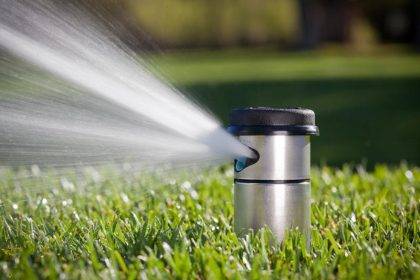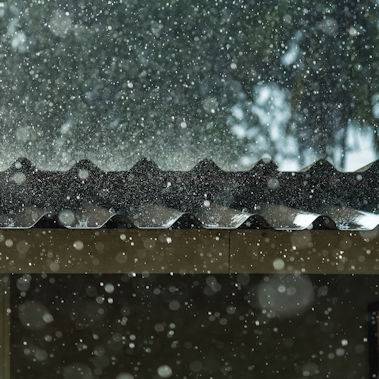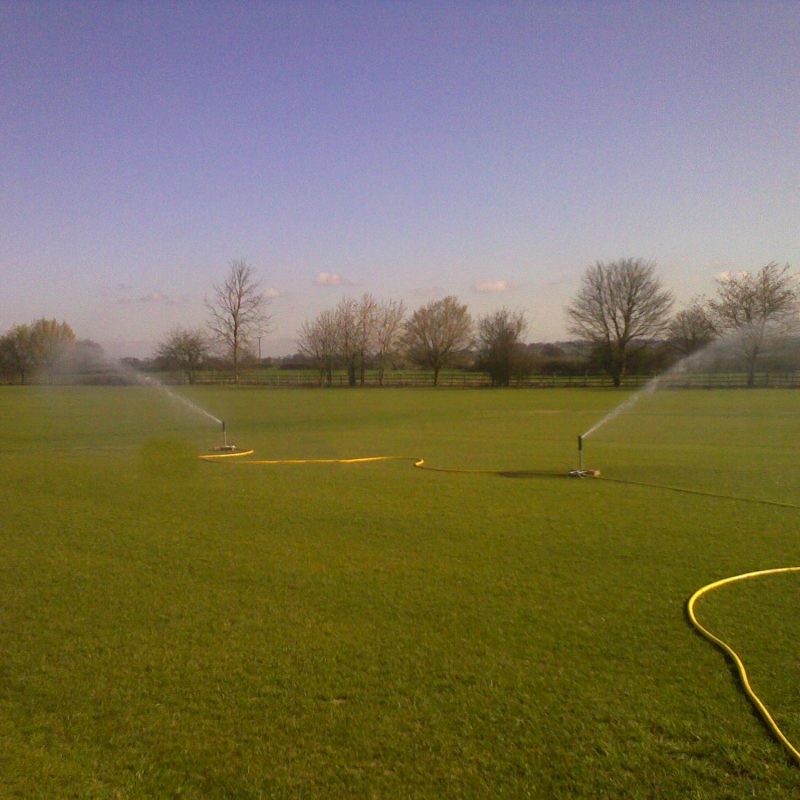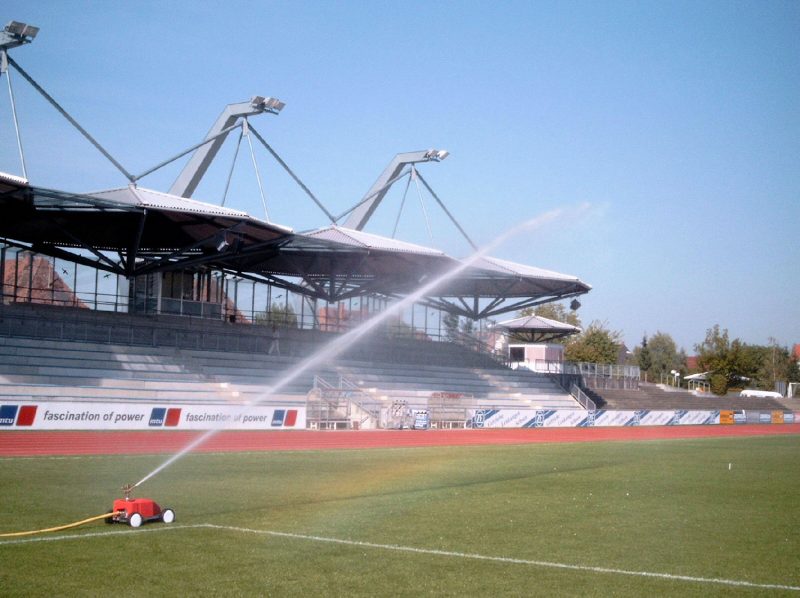 Watering a football pitch in dry weather is important for a good playing surface, a football pitch needs to have plenty of moisture in the soil – this ensures that the grass will grow and recover from games and also ensures the ball will travel properly over the surface. A hard pitch, baked by the sun, will result in a less predictable games and more injuries to players if they fall.
Watering a football pitch in dry weather is important for a good playing surface, a football pitch needs to have plenty of moisture in the soil – this ensures that the grass will grow and recover from games and also ensures the ball will travel properly over the surface. A hard pitch, baked by the sun, will result in a less predictable games and more injuries to players if they fall.
Premier League teams in England will have state-of-the-art irrigation systems which will automatically water the pitch in dry weather, enabling the grounds staff to keep the pitch in top condition. For smaller clubs and local football teams the task is harder as the cost of a fully automated irrigation system for watering a football pitch is high, with large tanks and pumps involved. However, as climate change bring hotter and drier summers to the UK, football pitch watering has become more important.
Football field sprinkler system costs
 Premier league clubs will spend tens of thousands of pounds on irrigation sprinklers fitted into the pitch, normally around the perimeter. These rise up out of the turf and throw water across the pitch. Due to the size of the irrigation sprinklers, the pumps required to operate the system are very expensive. A large amount of water is also required, although football stadiums have the advantage of large roof areas to catch rainfall.
Premier league clubs will spend tens of thousands of pounds on irrigation sprinklers fitted into the pitch, normally around the perimeter. These rise up out of the turf and throw water across the pitch. Due to the size of the irrigation sprinklers, the pumps required to operate the system are very expensive. A large amount of water is also required, although football stadiums have the advantage of large roof areas to catch rainfall.
For smaller clubs, this sort of system is out of the question. However, it is possible to water an entire pitch at a much smaller cost, well within the reach of amateur football clubs, especially if they can obtain grants. Unlike premier league irrigation systems, the irrigation systems on amateur club football pitched will require equipment to be taken out onto the pitch each time watering is required.
How much water does a football pitch need
Watering a football field requires a substantial amount of water. On a hot summer’s day in England, 3 litres of water will be lost from every square meter of the pitch. For a 110m x 70m pitch, this equates to 23,000 litres – 23 tonnes of water per day. In a dry week 160 tonnes of water need to be added to the pitch, the equivalent of a small lake.
Using recycled water for the football pitch
 Using rainwater to water the football pitch sound like a great idea, especially if you have a club house to catch the water from. The only problem is that when you need to water, it won’t have rained for a while, so the water needs to be stored for the longer term. In the south of England, to restore the moisture deficit for the months of June, July and August, on average you would need to use 949,000 litres of water, which is a lot of water to store – especially as the cost of using mains water would only be about £1,500 for the three months.
Using rainwater to water the football pitch sound like a great idea, especially if you have a club house to catch the water from. The only problem is that when you need to water, it won’t have rained for a while, so the water needs to be stored for the longer term. In the south of England, to restore the moisture deficit for the months of June, July and August, on average you would need to use 949,000 litres of water, which is a lot of water to store – especially as the cost of using mains water would only be about £1,500 for the three months.
When to water a football pitch
The most beneficial time to water a football pitch is at night – temperature evaporation rates are lower, ensuring more water reaches the root zone. By contrast, watering with a sprinkler in the middle of the day will see 85% of water wasted through evaporation. Timers can be used to ensure the irrigation system operated during the night.
The other advantage of night-time watering is that it leaves the pitches playable during the day. Ground staff can put the watering equipment and hoses out at night and then put them away before play the next day.
Spot watering football pitches
 The lowest cost method of football pitch watering is to just concentrate on the areas of the pitch with the highest use – goal areas and the centre circle. For this temporary turf sprinkler sets can be connected to a hose and run from a standard standpipe. Depending on the flow, 3 or 5 sprinklers can be run at a time, covering 250m2 or 400m2 of the pitch. ¾” or 1” hose is used to cope with the long runs and a hose trolley makes coiling and uncoiling the hose pipe much easier. A timer can be added to the tap to allow night-time watering of grass patches. With modern, low precipitation sprinklers, a week’s worth of water (21mm) can be added to the area in one night.
The lowest cost method of football pitch watering is to just concentrate on the areas of the pitch with the highest use – goal areas and the centre circle. For this temporary turf sprinkler sets can be connected to a hose and run from a standard standpipe. Depending on the flow, 3 or 5 sprinklers can be run at a time, covering 250m2 or 400m2 of the pitch. ¾” or 1” hose is used to cope with the long runs and a hose trolley makes coiling and uncoiling the hose pipe much easier. A timer can be added to the tap to allow night-time watering of grass patches. With modern, low precipitation sprinklers, a week’s worth of water (21mm) can be added to the area in one night.
Manual sprinklers for the football field
If the whole football pitch needs to be watered, the cheapest way of doing this is a line of sprinklers across the width of the pitch. This can run overnight to water that strip, then moved down the pitch the next night. Each strip watered is only 10m wide, so the sprinklers need to be moved 11 times to water an entire pitch.
The cost of a football pitch strip watering system starts at around £3,000 + VAT for all of the equipment, more if a pump is required to boost the pressure.
Watering the pitch with travelling sprinkler
Travelling sprinkler systems water the pitch in two or 3 strips down the length of the pitch – each strip is watered overnight. A small sprinkler cart is connected to a flexible hosepipe and slowly pulled down the length of the football pitch on a wire. The sprinkler shuts off once it reaches the other end of the pitch.
As the water flows and pressures are higher, these systems need a water storage tank and a pump to pressurise the system. These sprinkler systems start at just under £9,000 + VAT, including the pump, tank and underground pipe to bring the water from the pump to the pitch side.
Watering with a reel irrigator
Reel irrigators work in a similar way to travelling sprinklers, watering a strip the length of the football pitch, however the reel irrigator incorporates a hose on a drum that is wound in, pulling the sprinkler along. Again, these reel irrigator watering systems need storage tanks and pumps to cope with the higher flows, so start at around £7,000 + VAT for a single pitch system, or £16,000 + VAT for a two-pitch solution. Both packages include the pumping equipment and underground pipe.

